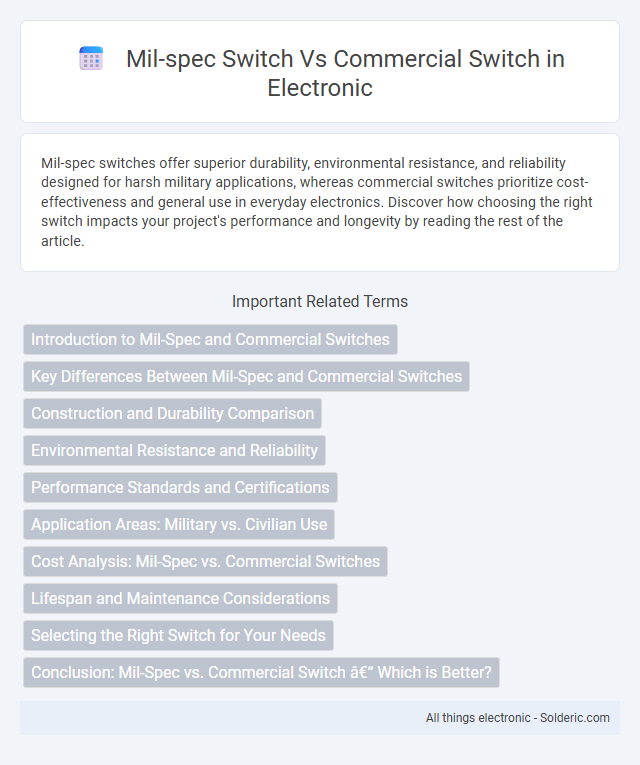Mil-spec switches offer superior durability, environmental resistance, and reliability designed for harsh military applications, whereas commercial switches prioritize cost-effectiveness and general use in everyday electronics. Discover how choosing the right switch impacts your project's performance and longevity by reading the rest of the article.
Comparison Table
| Feature | Mil-Spec Switch | Commercial Switch |
|---|---|---|
| Durability | High, designed for extreme environments | Moderate, intended for standard conditions |
| Temperature Range | -55degC to +125degC | 0degC to +70degC |
| Shock and Vibration Resistance | Meets MIL-STD-202 standards | Limited or none |
| Sealing | IP67 or higher, waterproof and dustproof | Varies, often IP20 to IP54 |
| Material Quality | High-grade metals and composites | Standard plastics and metals |
| Lifespan | Up to 1 million cycles | Typically 100,000 to 500,000 cycles |
| Cost | Higher due to robust design and certification | Lower, mass-produced for general use |
| Applications | Military, aerospace, industrial | Consumer electronics, appliances |
Introduction to Mil-Spec and Commercial Switches
Mil-spec switches are designed to meet rigorous military standards for durability, reliability, and environmental resistance, often conforming to specifications such as MIL-DTL-3950 or MIL-DTL-28748. Commercial switches, while varying widely in quality and application, primarily focus on cost-effectiveness and general consumer use without meeting stringent military-grade specifications. The key distinction lies in mil-spec switches' enhanced performance under extreme conditions, while commercial switches prioritize accessibility and broad market compatibility.
Key Differences Between Mil-Spec and Commercial Switches
Mil-spec switches are engineered to meet stringent military standards, offering superior durability, environmental resistance, and reliability under extreme conditions compared to commercial switches. Commercial switches prioritize cost-effectiveness and general use, often lacking the rigorous testing and robust materials found in mil-spec designs. Key differences include mil-spec switches having higher tolerance to vibration, temperature extremes, and moisture, along with certifications such as MIL-DTL-3950, which guarantee performance in harsh operational environments.
Construction and Durability Comparison
Mil-spec switches feature ruggedized construction with metal housings and sealed contacts designed to withstand extreme environmental conditions, including shock, vibration, and moisture. Commercial switches typically use plastic components and lack extensive sealing, making them less durable under harsh operational stresses. The superior durability of mil-spec switches ensures reliable performance in military and industrial applications where longevity and resilience are critical.
Environmental Resistance and Reliability
Mil-spec switches are engineered to withstand extreme environmental conditions, including high shock, vibration, temperature fluctuations ranging from -55degC to +125degC, and exposure to dust, moisture, and corrosive agents, ensuring consistent performance in critical applications. Commercial switches typically lack such rigorous sealing and durability standards, making them more susceptible to failure under harsh environmental stresses. The enhanced reliability of mil-spec switches stems from strict military standards like MIL-DTL-83723, which mandate extensive testing and quality control protocols.
Performance Standards and Certifications
Mil-spec switches are designed to meet rigorous military performance standards such as MIL-DTL-83723 and MIL-PRF-8805, ensuring superior durability, environmental resistance, and reliability in extreme conditions. Commercial switches typically adhere to industry standards like UL or IEC certifications but lack the stringent testing protocols required for military applications. Choosing a mil-spec switch guarantees your system complies with strict certification requirements vital for mission-critical performance.
Application Areas: Military vs. Civilian Use
Mil-spec switches are engineered for rigorous conditions in military applications such as aerospace, defense systems, and tactical equipment, ensuring reliability under extreme temperature, vibration, and shock. Commercial switches are designed for civilian use in consumer electronics, industrial machinery, and automotive systems, prioritizing cost-efficiency and general durability. The distinct manufacturing standards result in mil-spec switches providing enhanced performance and longevity in mission-critical environments compared to standard commercial switches.
Cost Analysis: Mil-Spec vs. Commercial Switches
Mil-spec switches typically incur higher costs due to stringent manufacturing standards, rigorous testing, and enhanced durability for extreme environments, making them suitable for aerospace, military, and industrial applications. Commercial switches are generally more affordable as they cater to less demanding consumer markets with lower performance and environmental stress requirements. The cost differential reflects the trade-off between reliability and price, where mil-spec switches justify higher expenses through extended lifecycle and superior operational integrity.
Lifespan and Maintenance Considerations
Mil-spec switches typically feature an extended lifespan, often rated for millions of cycles, ensuring durability in harsh environments where maintenance access may be limited. Commercial switches, while sufficient for everyday applications, usually have a shorter operational life and might require more frequent replacement or repairs under heavy use. Choosing a mil-spec switch enhances Your system's reliability and reduces downtime due to maintenance, especially in critical or demanding settings.
Selecting the Right Switch for Your Needs
Mil-spec switches feature rugged durability, high reliability, and resistance to extreme temperatures and vibrations, making them ideal for military, aerospace, and industrial applications. Commercial switches offer cost-effective, lightweight solutions suitable for everyday consumer electronics and less demanding environments. Assess your application's environmental conditions, required lifespan, and budget to select the switch that best matches your performance and durability needs.
Conclusion: Mil-Spec vs. Commercial Switch – Which is Better?
Mil-spec switches offer superior durability, reliability, and resistance to extreme conditions compared to commercial switches, making them ideal for military, aerospace, and industrial applications. Commercial switches are generally more cost-effective and suitable for everyday consumer electronics but lack the rigorous testing and robust construction of mil-spec counterparts. Choosing between mil-spec and commercial switches depends on the criticality of performance and environment, with mil-spec being better for high-stress uses and commercial switches fitting standard, budget-conscious needs.
mil-spec switch vs commercial switch Infographic

 solderic.com
solderic.com